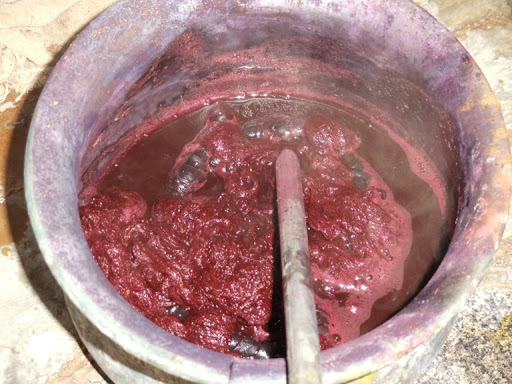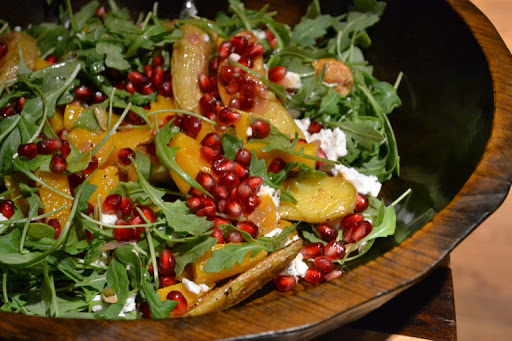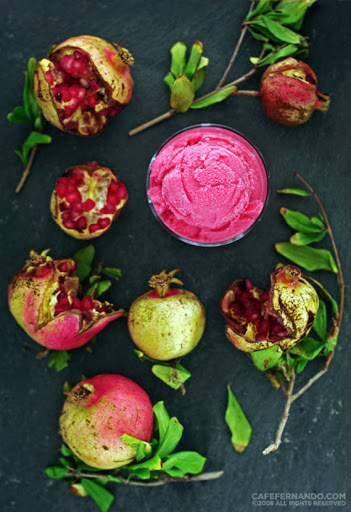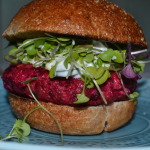The 411- Pomegranates on Meatless Monday
06
Oct 2014
According to myth, we suffer through winter because Persephone, the kidnapped daughter of Demeter {goddess of the harvest} was tricked into eating six pomegranate seeds while she was being held by Hades. When Demeter mourned for her, all green things ceased to grow. Zeus, being kingly and very in charge, could not allow the earth to perish, so Persephone was condemned to spending six months in the underworld, during which time the earth is barren. Now that we know Persephone and the pomegranate are responsible for all the formidable ugly winter weather New England is known for, let’s learn a bit more about this fruit du jour: Pomegranates on Meatless Monday.
The pomegranate is an ancient fruit with a rich history that has always been a part of the Middle Eastern diet. The fruit grows on a small bushy tree native to Iran and Iraq, and holds hundreds of tiny seeds, encased in a ruby pulp, that explode in your mouth with flavor. The tart juice is similar to cranberry, with a deeper taste. Nowadays, you can find the tree throughout the Mediterranean, parts of Asia, and Africa.
Pomegranates were everywhere when we visited a Mumbai market. The variety in India seemed to be filled with a greater amount of seeds then the ones we have here in the states.
Long thought to be a symbol of fertility, the ancient fruit appears in the diets of many cultures. Artists have often used it as a metaphor, and even today the juice is viewed as a natural remedy for increasing the chances of pregnancy.

Several years ago, outside of Hyderabad, India, I visited one of the few remaining weavers using natural dyes for his fabrics. The process is painstaking, and I was given a demonstration for the color of a beautiful, weathered red he used for much of the cloth. Here he boils the pomegranate skins and seeds to prepare the dye bath. The juice of the fruit stains indelibly, and was also used by ancient Egyptian women to color their lips.

Health claims abound about the leathery skinned fruit. The symptoms of heart disease, aging and cancer are all said to benefit from the sweet-tart juice. It’s loaded with antioxidants, vitamins, potassium, folic acid and iron. Sounds like pomegranates have taken on the roll of new superfood.
Most of the fruit in the US comes from California, and can be kept in the refrigerator for up to two months. You can find recipes for salads, soups, baked goods and cocktails all across the web-here are a few of my favorites.

You know I am a huge fan of Yotam Ottolenghi and his cookbook Plenty. This eggplant with buttermilk sauce topped with pomegranate seeds was a great starter for a recent dinner party.

Salads are a great spot to add the beautiful accent of the pomegranate seed. Toss together arugula, feta, roasted potatoes and seeds with your favorite dressing.

Finish up your meal with pomegranate frozen yogurt from the food blog of Cafe Fernando. This spot is so full of eye candy, you better pull up a chair. Cenk has many recipes for the fruit on his blog, and rumor has it that the author is coming out with a cookbook soon. I’ll keep you posted!
With pomegranates so plentiful in the marketplace, I’ve started adding them to just about everything. Sprinkled into my morning yogurt, or atop salads, they give a pop of color and just the right amount of crunch. I love the way they pop with flavor when you first bite down on the seeds.
Have you introduced this fruit into your diet? How do you like to enjoy it? Try the juice with seltzer for a refreshing, thirst quenching drink.
You may also like...







































Pomegranates are rich in antioxidants and I try to incorporate them in to lots of dishes. I even drop them into sparkling wine – the seeds are so colorful. I have the Plenty Cookbook too! The eggplant dish is divine!
They are a delicious addition to just about everything Suzanne. Sweet or savory, a flavor packed little punch.
Love pomegranates! One of my favorite juices (it doesn’t hurt to add vodka, either). Wonder if you’ve read Traveling with Pomegranates by Sue Monk Kidd (who wrote The Secret Life of Bees)? Inspiring, and I think of it every time I encounter the fruit and/or the word. 🙂
Thanks for the book recommendation Betsy. I haven’t read Traveling with Pomegranates, but loved The Secret Life of Bees.And yes, the juice is one of my favorite vodka mixers!
I do buy pomegranates in season and love them but hate the mess required to get at the fruit. I can understand why it’s used for a dye. That pomegranate frozen yogurt sounds divine. Wonderful photos.
Thanks Leigh-if you tap the fruit with the back of a wooden spoon, you can get the seeds to pop out. Still a bit messy, but your hands won’t be red!
Thanks for the wonderful info and ideas on pomegranates. We had a pomegranate tree in our backyard on St. Croix but didn’t know what to do with them but just eat them straight.
I can’t imagine going outside to pick a pomegranate, although I did see them growing in Turkey.Now you know, just in case the opportunity presents itself again.
All your photos make the fruit look so yummy! Very interesting!
Thanks Marilyn-it’s hard to take a bad photo of them, so many nooks and crannies, plus all that dripping juice….
What a literally beautiful post! One of my favorite pomegranate dishes is Chiles en Nogada, which I had most memorably in San Miguel de Allende in Mexico, http://travelswithcarole.blogspot.com/2009/10/good-eats-bugambilia-san-miguel-de.html
Michele and Carole-I had completely forgotten about Chiles en Nogado which I had in Pueblo, dreamy dish when it’s made well. Thanks for the memory!
I love your photos and summary of the history of pomegranates. I agree with Carole…one of my all-time fave dishes is chiles en nogada in Mexico – the bright seeds are a critical part of the red, while and green flag motif of this iconic dish. I’m going to give the recipe for eggplant with buttermilk a try that you’ve linked to. Thanks!
Aren’t they soooooo photogenic! But it is not a fruit I come across too often, so sadly, I don’t incorporate it into my diet as often as I’d like 🙂
I find the juice is really delicious too Linda-mixed with a bit of seltzer-it’s a real thirst quencher.
Like everyone else who’s commented, I love pomegranates and can remember picking and eating them from a friend’s yard in southern California when I was growing up. Can’t wait to try some of your recipes but I’ll start adding them to my salads right away. The color splash alone makes any dish look more appealing!
Anita, do let me know how you make out with the recipes. Lucky you to taste them right off the tree.
Pomegranate yogurt? Yumm… The fruit has an interesting history! (as lipstick, a fertility symbol) – learned something about it today :-).
One of the things I love about writing for Green With Renvy is the amazing factoids I learn in the process. This one was defiantly an eye-opener : )
Thanks for this great education on pomegranates. They are also so pleasing to the eye!
I think i’d like to do a whole series on photos of pomegranates. Such an interesting fruit Irene.
I love pomegranates… but I hate the seeds. As I was reading it occurred to me I could juice them – just throw the seeds into the machine and see what comes out!
As for Persephone, well, I’ll know who to blame the first time I get snowed in this winter.
You’ll find the juice very tasty and tart Leyla.
So versatile, colourful and good for you!
I agree, this is a fruit that you can enjoy so many different ways.
What some lovely ideas for pomegranates – I especially like the idea of putting them in a salad. Thanks for the tips and recipes 🙂
I don’t get to eat them often, but pomegranates are a real treat- didn’t know the folklore and history, though. Thanks.
Practically ever Egyptian breakfast I had while in Cairo & Lower Egypt had some variation on pomegranates. I’m glad you’ve written about it.
Pomegranates are relatively new to us in the states Milos. I’m a convert and eat them in everything from salads to cocktails.